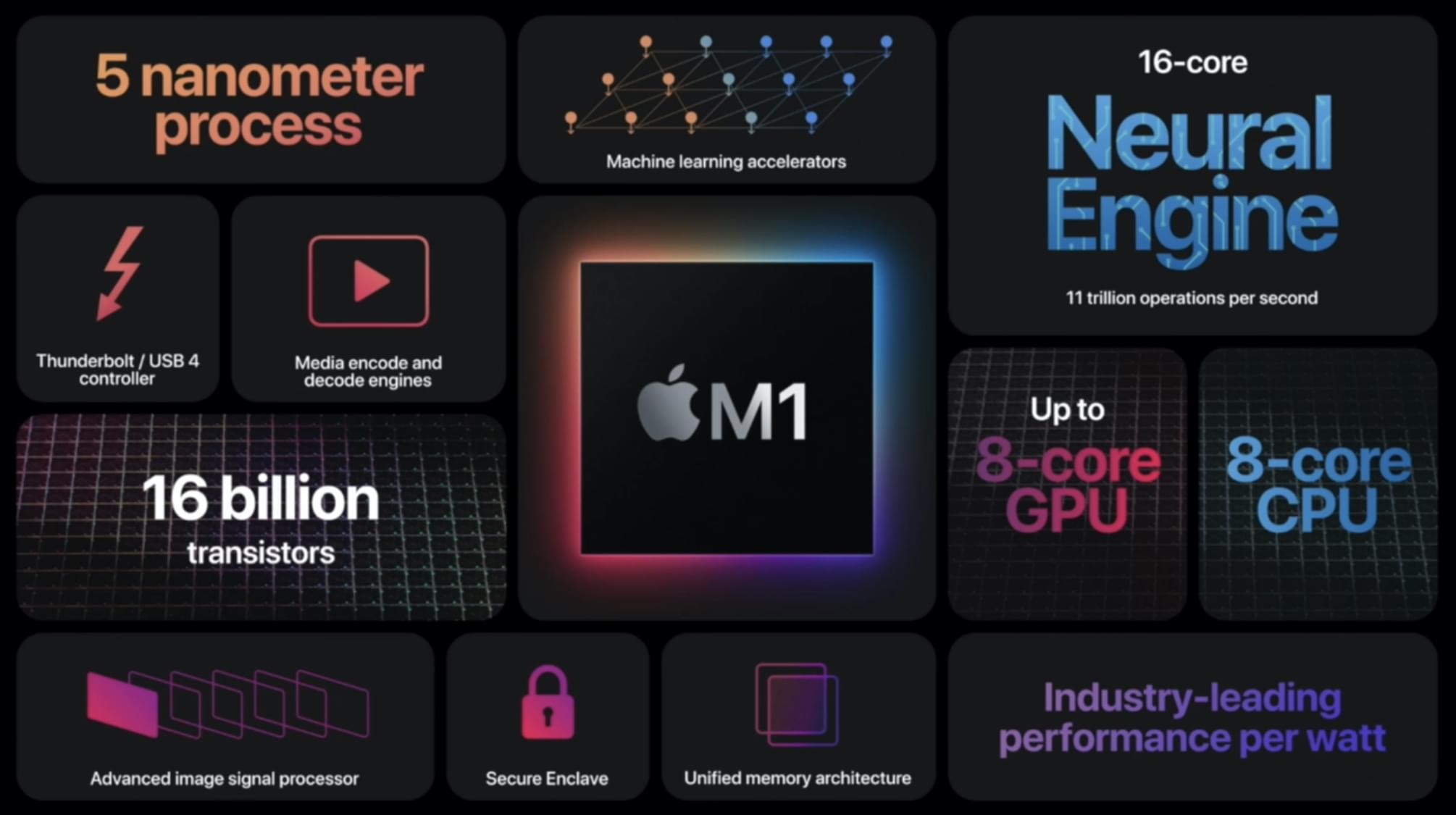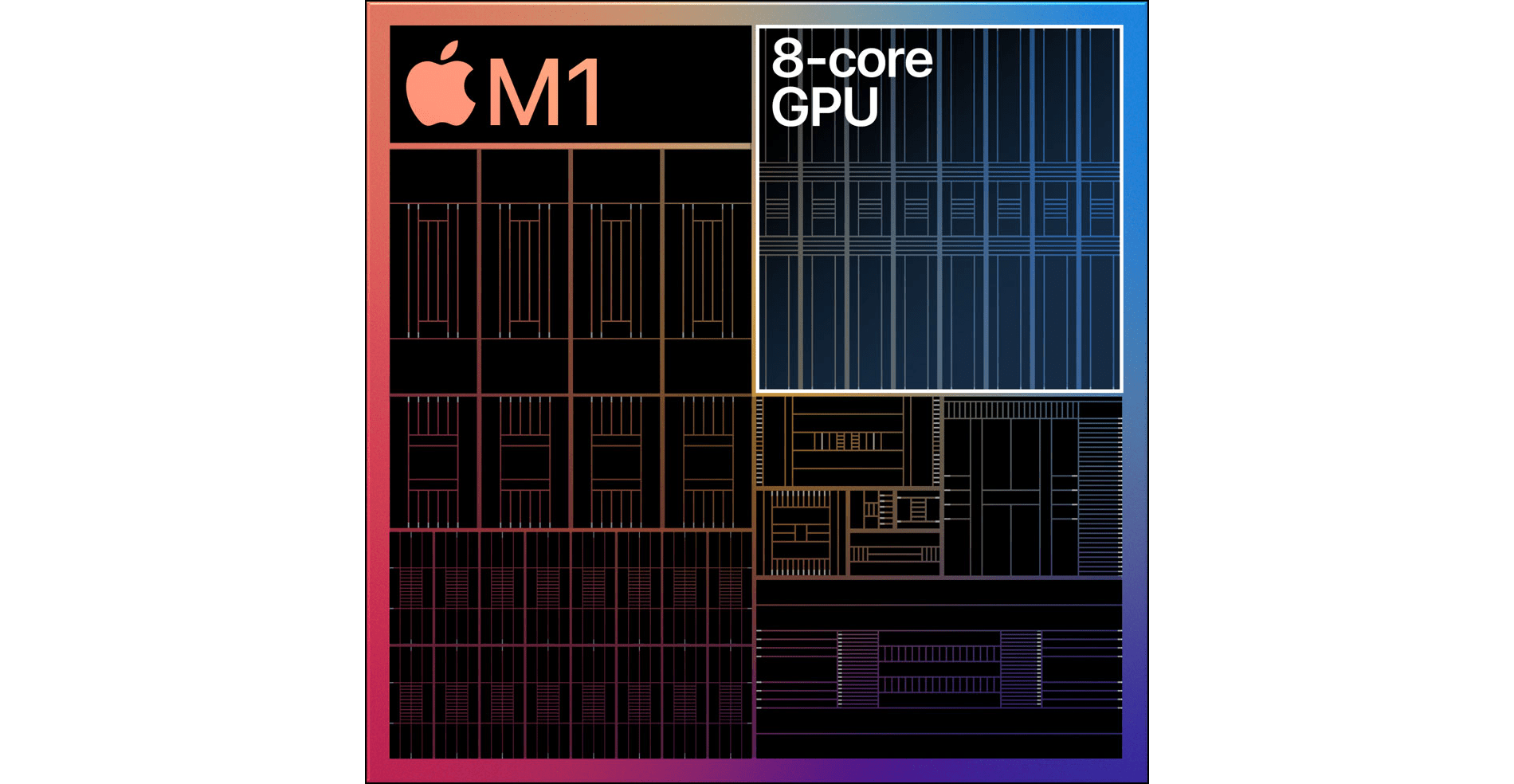During this morning’s Apple special event stream, SVP of Hardware Technologies Johny Srouji unveiled the first Apple silicon chip for Mac. The company teased this chip at WWDC in June, but we’ve had to wait until today for the full details. Chip transitions are never undertaken lightly, so expectations were high for how significant the advantages of Apple silicon would be. Thankfully, the M1 chip does not disappoint.
The M1 ushers in one of the largest single-generation leaps in performance and power efficiency for Apple hardware in recent history. It is a system on a chip (SoC), meaning it has pulled multiple different chip types from prior Macs together into one package. Assembled using a 5-nanometer process, the M1 is packed with 16 billion transistors. The result is a highly power-efficient chip which can deliver impressive performance while maintaining the longest battery life ever for Mac laptops.
CPU
Apple’s M1 chip features an 8-core CPU which Apple is billing as the highest-performance CPU they have ever built. The cores have split functionalities: four for high performance and four for high efficiency. This is a CPU strategy which Apple has been using in its A-series chips for years to efficiently power iPhones and iPads. According to Apple, the M1 chip can run at double the speed of the latest PC laptop chip while running at 10 watts, which is the thermal envelope of the MacBook Air. Apple’s chip uses only a quarter as much power as this PC chip when matching its peak performance.
We’ll have to wait on benchmarks of the new M1-powered Macs to verify Apple’s claims, but these numbers sound incredibly impressive. The new M1-powered MacBook Pro and Mac mini should be even faster since they can operate at higher wattage levels.
GPU
The M1 features integrated graphics in the form of a GPU with up to 8 cores. The 8-core version can execute almost 25,000 threads at a time, resulting in what Apple claims to be the world’s fastest integrated graphics in a personal computer. Unsurprisingly, the M1 GPU also operates incredibly efficiently. It uses only a third as much power as the latest PC laptop chip when matching that chip’s max performance. At its own max performance, Apple’s GPU doubles the performance of the PC chip.
Apple hasn’t revealed exactly which PC chip it is referring to in these comparisons, but it’s fair to assume that they’re targeting one of the most recent Intel laptop chips.
Neural Engine
A 16-core Neural Engine is also included on the Apple M1. This chip targets machine learning operations, and is capable of executing up to 11 trillion operations per second. Apple claims that this enables 15x faster performance in machine learning tasks in the new M1 13” MacBook Pro when compared to unspecified “latest‑generation high‑performance notebooks.” Machine learning tasks are growing rapidly in modern professional workflows, so many pros should see the benefits of this speed improvement when using applications such as Final Cut Pro, Adobe Photoshop, Pixelmator Pro, and many others.
Secure Enclave
The final significant chip built into the M1 is Apple’s Secure Enclave. The Secure Enclave handles security-critical operations such as authentication and file encryption, and enables hardware-verified secure boot for M1 Macs running macOS Big Sur. Apple has been building Secure Enclaves into its A-series chips for iPhones and iPads for years, and has even included them in recent Macs via their T-Series chips. The M1 allows Apple to remove T-series chips from new Macs entirely because it brings that functionality into the main SoC.
Unified Memory Architecture
One of the ways in which Apple’s M1 chip is able to achieve such blazingly fast speeds is by using a unified memory architecture (UMA). This means that each aspect of the chip (CPU, GPU, Neural Engine, etc) are utilizing the same pool of memory. Traditional architectures require data to be copied back and forth between various memory pools, which naturally slows down operations. One of the direct results from this change, according to Apple’s numbers, is 3.9x faster video processing and 7.1x faster image processing when comparing the M1 MacBook Air to a current generation MacBook Air running a 1.2GHz quad-core Intel i7 processor.
Conclusion
Going into this event, we were looking for Apple to justify this transition to a new chip architecture. Developers will need to recompile their apps and in some rare cases may need to make more significant changes to get them working. Some use cases, such as those which require running Windows on a Mac, may become much more difficult if not impossible due to this transition.
We already knew from WWDC that Apple silicon chips would enable running iOS and iPadOS apps on the Mac, which is a great benefit alone. The remaining questions revolved around the performance improvements that Apple would be able to garner from taking control of chip hardware. Today, Apple answered those questions pretty resoundingly.
The M1 is the first of (presumably) many Apple silicon chips, but it has hit the ground running. The performance gains alone appear to be significantly higher than any we’ve seen in recent years. Paired with the incredible improvements in power efficiency, I think Apple has clearly justified this architecture transition. Furthermore, now that Apple has taken control of its chips and no longer needs to wait for Intel chip advancements, we will hopefully see more regular improvements to Mac performance for years to come.
You can follow all of our November event coverage through our November 2020 event hub, or subscribe to the dedicated RSS feed.






